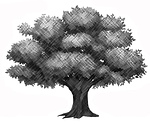Discovering Your Mysterious Ancestors
Genealogical research can help you learn about your recent ancestors, but what about the deeper past? Models vary, but you probably had over 1,000 ancestors living contemporaneously just 300 years ago in 1700. DNA tests can provide great big-picture insights about one’s ancestry going back thousands of years into human history.
Many companies offer genealogical DNA tests you can buy for between $70 - $200. Most tests just need you to spit into a tube or swab your cheek, mail the sample back to the company and wait a few weeks for analysis. The tests compare your sample to ‘reference populations’: other people who have been tested from known populations and geographic areas.
This comparison is based on SNPs (pronounced “snips”) or single-nucleotide polymorphisms. SNPs are small parts of your genetic code that can be used to compare genetic similarities and differences between people. While there is no gene for being Greek or Navajo, generations of people living in a region tend to share a lot of the same SNPs. Sometimes these genetic population groups coincide with cultural identities like ethnicity and religion (for example Maori, French, Bantu or Ashkenazi Jewish). The complexity of human history due to genetic variation, frequent migration and intermarriage occurring consistently across thousands of years means the genetic characteristics underlying cultural identities are more like a unique mosaic. DNA ancestry tests let you take a peek at the pieces that form your mosaic.
National Geographic's Geno 2.0 kit ($199.95) is the most comprehensive test. This kit analyzes the genes across all of your chromosomes (the tightly-wound packages of genetic code that you got from your biological parents). This test identifies your genetic similarity to 60 reference populations and identifies the haplotype of your male (paternal) and female (maternal) lineages, placing them among huge groups of genetically-related people called haplogroups. The National Geographic test also identifies what percentage of your ancestry is from two other human species: Neanderthals and Denisovans.
You can buy the most straightforward test from AncestryDNA ($79.99). This is the best test if you want to know what reference populations your ancestors were most similar to. The test compares SNPs located on the hybrid chromosomes that you got from your mother and father called autosomal chromosomes. AncestryDNA then calculates the percentage of your genes that came from each of the 350 different reference populations in their database - the most diverse database in the industry. You also get one month of free access to their database of genealogical documents at Ancestry.com. Another popular test is 23andMe, which has two products. One provides ancestry estimates with over 150 ethnicities, maternal and paternal haplogroups, and Neanderthal ancestry for $99. In the next level ($199) the company also includes insight into genetic traits and health predispositions.
MyHeritage ($99) provides genetic ancestry analysis from your autosomal chromosomes by comparing your SNPs to 42 different reference populations. Family Tree DNA ($79) offers an autosomal genetic ancestry test that matches your SNPs to 33 reference populations as well as to ancient populations. Starting at $169, they also offer tests that analyze your genetic ancestry and the haplogroups of your maternal and paternal lineages. Every test except for National Geographic’s also offers options to contact other users who might be extended cousins. All tests also let you download your raw genetic data to your computer. You can upload your data to free services like GEDmatch to gain even more insight into your genetic past. You can even compare your DNA to ancient individuals whose remains have been archaeologically recovered! And you may discover surprising information about yourself and your family.


